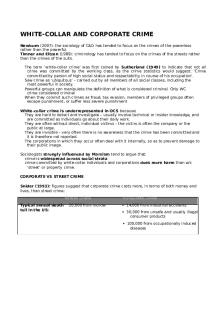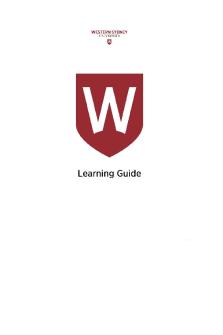Sociology of crime and deviance lecture notes- week 23- Corporate Crimes and Harms PDF

| Title | Sociology of crime and deviance lecture notes- week 23- Corporate Crimes and Harms |
|---|---|
| Course | Sociology of Crime and Deviance |
| Institution | University of Kent |
| Pages | 5 |
| File Size | 160 KB |
| File Type | |
| Total Downloads | 85 |
| Total Views | 141 |
Summary
Sociology of crime and deviance lecture notes...
Description
Sociology of crime and Deviance- Week 23- Corporate Crimes and Harms.
The Chicago School recap
Crime is a product of ‘social disorganisation’ of the ‘Zone-in-transition’ (the inner city). Sociological positivism o Cause of crime = an ‘abnormality’ of the social conditions of a city area – potentially correctable (disorganisation, deprivation, poverty, unemployment, etc.) o Crime thus seen as a problem of the ‘lower’ classes of the city. o Reflects official statistics and the popular perception. Sutherland’s critique: less the ‘social disorganisation’ of an urban zone, more ‘differential association’- crime is learnt behaviour; anyone can (and does) learn the values and rules of crime through social/cultural contact. New concept... white collar crime
Sutherland’s ‘White-Collar Criminality’ (1939-40)
Pathbreaking Presidential Address to joint conference of American Sociological Society and American Economic Society, 1939, Philadelphia Paper in the American Sociological Review, 1940 o Explicitly apolitical, aim only to reform criminology (not a ‘muckraking’ exercise) Just aims at reforming criminology. o Criminology mistakenly bases itself on official statistics based on how the CJS operates; these are ‘biased samples’. o Crime not correlated with ‘poverty or with the psychopathic and sociopathic conditions associated with poverty’- due to biased sample criminology chooses to study. o Instead he decides to address the crime of ‘business and professional men’ o The “respected”, “socially accepted and approved”, “looked up to” o Refers to the so-called “robber barons” of the 19th century, e.g. those who ran the railroad companies, but also the ‘many other merchant princes and captains of finance and industry, and a host of lesser followers’ of the present day. o We can read about this crime in the financial pages but not in the main newspaper pages.
He mentions examples in business. o financial statement fraud equates to ‘80%’ in listed corporations accounts. o stock exchange manipulation- e.g false figures released to increase the price of shares. o commercial bribery o bribery of public officials (in contracts, or in lobbying for legislation e.g of civil servants or ministers ect in search for law that is favourable for a corporation) o embezzlement o consumer dishonesty, fraud o tax fraud o channelling funds in bankruptcy, etc. Al Capone called these “the legitimate rackets”... Examples also in the medical profession and in politics Cost much greater than in official crime, both financially and in ‘social relations’ (violations of trust, ‘social morale’) o E.g financial costs, lives harms Criminologists should rethink their sole focus on the criminal courts o all the above offences are criminal but mostly processed by administrative regulation, or in the civil courts they have been decriminalised o ‘class bias’ of the courts o ‘power of their (CEOS, shareholders ect) class to influence the implementation and administration of law’ Sutherland rethinks ‘social disorganisation’ Differential association culminates in crime o because the community is not organised solidly against that behaviour. [...] In business, “the rules of the game” conflict with the legal rules’. Business works according to different kinds of rules and legal rules. If legal rules represent the shared values of society, then the rules/values of businesses seem to be different. o Competition between companies, e.g. the use of commercial bribery justified by competition- in conflict with legal rules. o Individual or group interests are given priority over the ‘general social welfare’
Sutherland’s White-Collar Crime(1949/1983)
White Collar Crime (1949) White Collar Crime: The Uncut Version (1983) Case histories of 70 of the largest business corporations, and 15 power and light) utility companies in the USA, 1929-1938, and in certain cases during WW2 average 14 violations each corporation included irregular labour practices, breaking trades unions, war-time profiteering, secret cartels, etc. Publisher feared litigation, and his university (Indiana) feared alienating business donors thus names of corporations, plus other identifying information, as well as significant passages were deleted. ‘Uncut’ version published 1983 o Names included American Sugar, American Tobacco, General Motors, Loew’s, Paramount, Roebuck, Sears, US Steel, Warner Brothers...
In the book, Sutherland defined white-collar crime as “a crime committed by a person of high social status and respectability in the course of his occupation” (p.9) Donald Cressey observed a tension that opened up in Sutherland’s work, between a focus on individual behaviour (differential association) and corporate ‘behaviour’ Debate with Tappan over whether crime-equivalent harm could be labelled crime
Corporate crime – definitions
Marshall Clinard and Richard Quinney (Criminal Behaviour Systems, 1973) ‘Corporate crime’ o officials in the corporation commit criminal/harmful acts to further the aims of the corporation. ‘Occupational crime’ o crimes committed by individual employees, whether against the corporation, workplace or consumer individuals acting on their own for personal gain Harms of corporate crime much greater than occupational crime Laura Schrager & James Short (1978)- corporate deviance o Corporate crime better understood as ‘organisational’ rather than as the product of individual actions. Structures of the organisation
Corporate crime – types of offence
Types (after Tombs) Financial offences illegal share dealing, insider trading (someone in the company knows information about the company, so can tip others to buy or sell shares to benefit them) fraudulent derivatives trading Financial crisis of 2007/8- caused decade of austerity- which was a result of major fraudulent trading, no one convicted. false financial statements collusion of auditors tax avoidance/evasion- small boundary between avoidance and evasion bribery money laundering (cleaning money up)- cant have trafficking (e.g human, animal ect) without money laundering Offences against consumers false advertising sale of unfit/harmful products ‘mis-selling’ financial products fraudulent safety testing-pollutants in cars put things in place to prevent those who tested their cars finding the real pollutant rate. price-fixing cartels Crimes against employees and employment protection discrimination (gender, ethnicity, sexuality) under-payment of wages- e,g Uber not paying holiday ect violation of union rights
health and safety infractions Environmental offences pollution toxic waste dumping
Corporate crime – why?
Joel Bakan The Corporation (book and film, 2003) A systemic/organisational problem, not just deviant individuals Corporations have a primary duty to shareholders, thus short-term profit is a priority over and above social obligations Social obligations seen as ‘externalities’ An analogy is drawn. A corporation acts like a psychopathic or sociopathic individual (as defined by DSM of the APA) o Hence, the corporation acts only in self-interest without care for any wider social harm which it will try to deny or neutralise
Corporate crime – causes? criminological theory
Rational-calculating individuals? o organisation amoral calculation (no values) o weak deterrence due to rarely getting caught and insignificant punishments (see Pearce and Tombs, 1998) o Abnormal individuals? Social disorganisation? Differential association? o Sutherland: the practice of business norms ‘favourable to the violation of law’ Strain/anomie? o Passas (1990) Merton’s theory of anomie just as applicable to corporations striving for money-success reinforced by capitalism. corporations aim to maximise profit. anomie – normlessness – money success Subculture? values? Labelling/social reaction? Marxist understandings? o Willem Bonger Criminality and Economic Conditions (1916) culture of capitalism egoism o erodes the values of altruism cupidity (~ greedy desire) same basic dynamics for crimes of the ‘lower classes’ as for crimes of the ‘upper classes’ ‘Crimes committed by the bourgeoisie’ (business owners) specific to capitalism: 1- Attempts to escape dishonour, failure, ruin, etc. (fear of falling)
2- Cupidity, i.e. greedy desire 3- ‘Great’ criminals (akin to the professional criminals of the lower classes), including fraud, promoting business failure (money made from bankruptcy), financial crimes, rigging share dealing, etc. Frank PearceCrimes of the Powerful (1975) Gary Slapper and Steve Tombs Corporate Crime (1990) Steve Tombs & Dave Whyte The Corporate Criminal: Why corporations, must be abolished. (2015) See also the ideas of Passas (above)
o o o o o...
Similar Free PDFs

Sociology of Crime & Deviance
- 4 Pages

Sociology notes on deviance
- 18 Pages

Sociology of Deviance (Erikson)
- 9 Pages
Popular Institutions
- Tinajero National High School - Annex
- Politeknik Caltex Riau
- Yokohama City University
- SGT University
- University of Al-Qadisiyah
- Divine Word College of Vigan
- Techniek College Rotterdam
- Universidade de Santiago
- Universiti Teknologi MARA Cawangan Johor Kampus Pasir Gudang
- Poltekkes Kemenkes Yogyakarta
- Baguio City National High School
- Colegio san marcos
- preparatoria uno
- Centro de Bachillerato Tecnológico Industrial y de Servicios No. 107
- Dalian Maritime University
- Quang Trung Secondary School
- Colegio Tecnológico en Informática
- Corporación Regional de Educación Superior
- Grupo CEDVA
- Dar Al Uloom University
- Centro de Estudios Preuniversitarios de la Universidad Nacional de Ingeniería
- 上智大学
- Aakash International School, Nuna Majara
- San Felipe Neri Catholic School
- Kang Chiao International School - New Taipei City
- Misamis Occidental National High School
- Institución Educativa Escuela Normal Juan Ladrilleros
- Kolehiyo ng Pantukan
- Batanes State College
- Instituto Continental
- Sekolah Menengah Kejuruan Kesehatan Kaltara (Tarakan)
- Colegio de La Inmaculada Concepcion - Cebu












